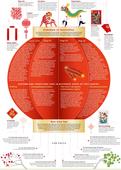One Grand Canal, two Qing Dynasty emperors and a series of devastating floods all conspired to give birth to a centuries-old Spring Festival tradition, Yang Yang reports.

The earliest record of the Dragon King Temple in Zaohe town in Jiangsu province's Suqian-a city along the Grand Canal that connects Beijing with Hangzhou-was in 1549.
At that time, there was a temple in Zaohe where people prayed to the Buddha Avalokitesvara for protection, especially during Spring Festival. And this ritual gradually evolved into a temple fair.
One summer during the Ming Dynasty (1368-1644), a flood busted through the Yellow River's watercourse, and water rushed into Suqian's Luoma Lake, submerging villages and fields. Flooding subsequently became a common problem in the area.
In 1594, the Yellow River's floodway temporarily cleared up after treatment, so people went to the temple to thank the Buddha.
During the Qing Dynasty (1644-1911), emperors attached great importance to Suqian's flooding.
The Grand Canal's middle section was completed during the reign of Kangxi (1662-1722), so the emperor sailed down the canal to inspect the south.
When he arrived in Suqian, he found the flooding seriously threatened people's living conditions and livelihoods. He ordered the temple to be rebuilt as the Dragon King Temple as part of the project.
People came to the temple every Spring Festival to pray for protection.
During the reign of Qianlong (1735-95), the emperor, like his grandfather, Kangxi, also left the Forbidden City and traveled along the Grand Canal to inspect the country.
When he arrived in Zaohe, officials told him that it was his grandfather who'd rebuilt the temple. As an admirer of his grandfather, Qianlong paid a visit and, upon finding it to be quite pleasant, decided to stay there for several nights.
During five of his six trips to the south from 1733 to 1760, Qianlong spent several nights at the temple. Consequently, it became colloquially known as the Qianlong Residence.
Since the Ming Dynasty, the temple fair has fallen on the ninth day of the first lunar month every year and reached its peak during Qianlong's reign.
Gradually, more people gathered at the fair-not only pious supplicants but also merchants, craftspeople and various kinds of performance troupes from the neighboring four provinces: Jiangsu, Anhui, Henan and Shandong.
In ancient times, Spring Festival was a slack farming season. Farmers from nearby towns went to the temple fair to not only worship but also to buy children's toys, farm tools and utensils that weren't available at other times of the year, such as wooden spades, reed mats, badou (handmade wicker baskets for carrying grain), shoulder poles, wooden swords and lanterns.
Some troupes brought floats to the fair and performed "land-boat dances", while others performed acrobatics.
Eventually, the temple fair was extended from one to three days, starting from the eighth day of the first lunar month, on which fireworks and firecrackers craftspeople gathered in Longtan Square to set off their wares before competing for the next day's business.
On the 10th day, all the troupes would perform at the temple's entrance.
"The first 15 days of the first lunar month were a peak time for folk activities," says Wang Lide, former director of the temple's Residence Heritage Management Institution.
"Because of the large audience, troupes would make a lot of money during this time."
The Dragon King Temple Fair has continued for centuries before the COVID-19 pandemic, carrying on through wars and hardship-even during the "cultural revolution" (1966-76), when worshipping activities were banned, but commercial and cultural activities continued.
In 2017, Jiangsu listed the Dragon King Temple Fair on the ninth day of the first lunar month and the traditional performance of Liuqin Opera, which takes its name from a plucked musical instrument, performed there as provincial-level intangible cultural heritage.
"In the last several years, the temple fair's scale has continued to grow, with more goods sold and more people visiting," Wang says.
It hosts 150,000 to 200,000 daily visitors on average, he adds.
The fair runs from 10 am to 4 pm. Visitors typically head to the temple after eating breakfast at home.
First, they buy joss sticks and burn them in front of statues depicting gods and deities to pray for good luck. Then, they stroll through the fair, where they buy food and other goods.
"The most important thing is to feel the atmosphere," Wang says.
What's unique about this particular fair, Wang notes, lies in its connection with emperors. Because Kangxi rebuilt the temple and Qianlong later paid several visits, the fair hosts an "imperial parade" on the ninth day of the first lunar month.
Indeed, the celebration at the Dragon King Temple remains a fair with much fanfare.
Contact the writer at yangyangs@chinadaily.com.cn


